| 216
|
CARLOS HELPS ALONZO LEARN TO WALK
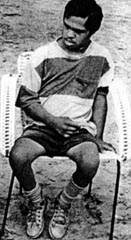
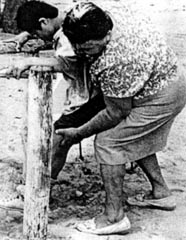
ALONZO is a 17-year-old youth with a condition
called Cretinism, which he was born with because his mother lacked foods
with enough iodine during pregnancy. Alonzo is developmentally delayed and
small for his age. He speaks only a few words. He frowns a lot. To nearly
every request he snaps "No!" Physically, he is strong and should have been
able to walk, but he did not. To move him, his mother half-carried and
half-dragged him. When she tried to help him stand or walk, he would sink
to his knees.
The PROJIMO team invited Alonzo and his mother to stay at the center
for a few days, to help him start walking. But Alonzo refused to
cooperate. His mother did her best to stand him at the parallel bars, but
he stubbornly resisted.
Inez, who helps with physical therapy, had an idea. He asked Carlitos
to help teach Alonzo. Carlos (who, like Alonzo, had resisted beginning to
walk when first at PROJIMO) loved the idea. Carlos started by
demonstrating how he could walk between the bars.
"Look!" he cried. "Carlos can walk. So can you!" Alonzo watched with
wonder.
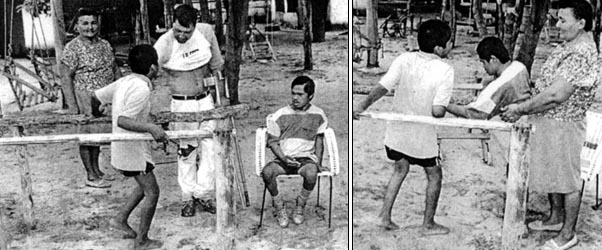
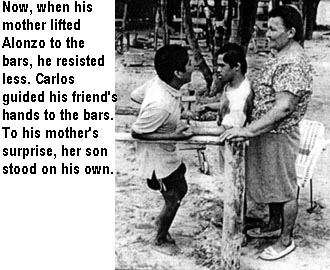
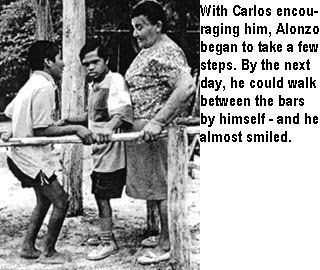 |
| 217
|
Alonzo Discovers the Advantage of Carlos' Walker
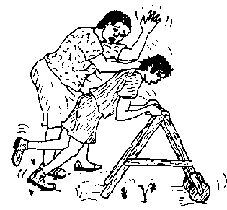
By the second day, Alonzo was more confident and willing to walk at the
bars. His mother wanted him to try a walker. Inez chose a big blue wooden
walker with front wheels. At first Alonzo refused. So Carlos paraded back
and forth on his own walker. Alonzo decided to try.
But a problem arose. Alonzo would push his walker and take small steps.
But his feet did not keep up with his body. He leaned farther and farther
forward until he almost fell. His frightened mother would jump to catch
him. After a few near-falls, Alonzo and his mother grew discouraged.
Suddenly Alonzo, scowling, pointed at Carlos who was parading back and
forth on his long wooden walker-with-a-seat.
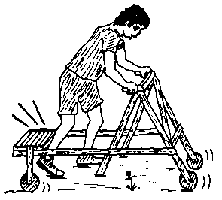
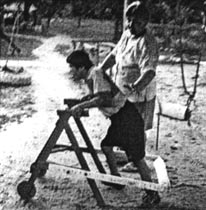
"Do you want to try Carlos' walker, Alonzo?" asked Inez intuitively.
Alonzo frowned ... but he did not say "No!" "That means Yes!" his mother
interpreted. ("Yes" was not part of Alonzo's vocabulary.)
Carlos willingly moved to his wheelchair. Inez helped Alonzo step into
his friend's walker. Without prompting, Alonzo began to walk. As before,
he started to lean forward precariously. But before he fell, his legs
bumped into the seat behind him, acting like a brake. With this braking
action, Alonzo felt safer. By evening he was running all around the
playground, his nervous mother close on his heels. Bruised stripes formed
on the back of his calves from the many bumps against the seat edge. But
Alonzo was so excited about his new skill that he did not mind.
|
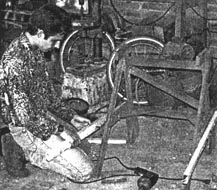
Building on Alonzo's discovery, the next day Polo modified the big
blue walker.
He attached some adjustable side-bars that extended backward to
support a padded cross-bar, to function as a leg-brake. |
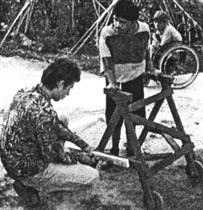
On testing, the new leg-brake worked fairly well. But Alonzo still
leaned forward a lot. His mother still hovered over him, fearing he
would fall. So Polo adjusted the rear brake-bar closer to the walker. |
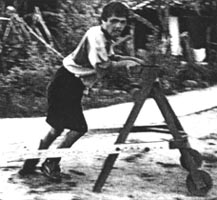
Now, with less leg room, it stopped Alonzo from leaning forward as
much. He could walk more upright, and with greater control.
At last his mother was willing to stand back and let him walk
alone. |
|
| 218
|
Carlos Helps Alonzo To Walk By Holding a Rope
To help Alonzo improve his balance so that eventually he could walk
without any assistive device, the PROJIMO team suggested that his mother
encourage him to walk while holding onto a rope stretched between two
trees. The rope, being less stable than parallel bars or a walker,
requires more balance. Rope walking can therefore be
another step toward independent walking. At first the rope can be
stretched tight, then gradually loosened as the child's balance and
control increase.
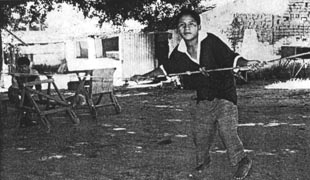
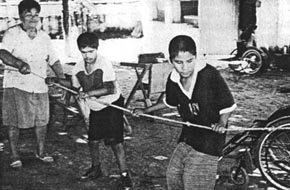
As with the parallel bars and the walker, at first Alonzo was afraid to
try to stand or walk holding the rope. Once again, Carlos came to the
rescue. He walked back and forth holding the rope while Alonzo sat
watching him. At last Alonzo was willing to try. First he hung fearfully
onto the rope without moving. Then Carlos coaxed him into a "follow the
leader" game, back and forth along the rope. In the end, they both had a
good time.
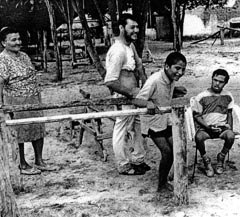
In 4 days at PROJIMO Alonzo made great progress learning to walk - and
with trying new things. His mother learned to be less over-protective and
to let Alonzo do more on his own, even if it meant taking some risks. For
Carlos, being asked to assist another child with problems similar to his
own was a marvelous experience. He took joy and pride in helping. Folks at
PROJIMO remembered how unreachable Carlos had been when he first came, and
realized how far he had come.
Like many of us, Carlos discovered that one of the greatest joys in
life comes from reaching out to others in need.
For more about Carlos, see Chapter 34.
|
|